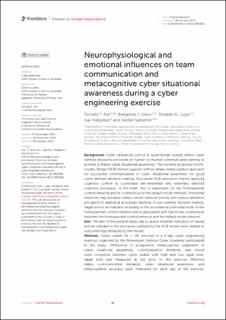| dc.contributor.author | Ask, Torvald Fossåen | |
| dc.contributor.author | Knox, Benjamin James | |
| dc.contributor.author | Lugo, Ricardo Gregorio | |
| dc.contributor.author | Helgetun, Ivar | |
| dc.contributor.author | Sütterlin, Stefan | |
| dc.date.accessioned | 2023-02-17T10:22:33Z | |
| dc.date.available | 2023-02-17T10:22:33Z | |
| dc.date.created | 2022-12-16T10:18:18Z | |
| dc.date.issued | 2023 | |
| dc.identifier.citation | Frontiers in Human Neuroscience. 2023, 16, Artikkel 1092056. | en_US |
| dc.identifier.issn | 1662-5161 | |
| dc.identifier.uri | https://hdl.handle.net/11250/3051888 | |
| dc.description.abstract | Background: Cyber operations unfold at superhuman speeds where cyber defense decisions are based on human-to-human communication aiming to achieve a shared cyber situational awareness. The recently proposed Orient, Locate, Bridge (OLB) model suggests a three-phase metacognitive approach for successful communication of cyber situational awareness for good cyber defense decision-making. Successful OLB execution implies applying cognitive control to coordinate self-referential and externally directed cognitive processes. In the brain, this is dependent on the frontoparietal control network and its connectivity to the default mode network. Emotional reactions may increase default mode network activity and reduce attention allocation to analytical processes resulting in sub-optimal decision-making. Vagal tone is an indicator of activity in the dorsolateral prefrontal node of the frontoparietal control network and is associated with functional connectivity between the frontoparietal control network and the default mode network. Aim: The aim of the present study was to assess whether indicators of neural activity relevant to the processes outlined by the OLB model were related to outcomes hypothesized by the model. Methods: Cyber cadets (N = 36) enrolled in a 3-day cyber engineering exercise organized by the Norwegian Defense Cyber Academy participated in the study. Differences in prospective metacognitive judgments of cyber situational awareness, communication demands, and mood were compared between cyber cadets with high and low vagal tone. Vagal tone was measured at rest prior to the exercise. Affective states, communication demands, cyber situational awareness, and metacognitive accuracy were measured on each day of the exercise. Results: We found that cyber cadets with higher vagal tone had better metacognitive judgments of cyber situational awareness, imposed fewer communication demands on their teams, and had more neutral moods compared to cyber cadets with lower vagal tone. Conclusion: These findings provide neuroergonomic support for the OLB model and suggest that it may be useful in education and training. Future studies should assess the effect of OLB-ing as an intervention on communication and performance. | en_US |
| dc.language.iso | eng | en_US |
| dc.publisher | Frontiers Media S.A. | en_US |
| dc.relation.uri | https://prosjektbanken.forskningsradet.no/project/FORISS/302941 | |
| dc.rights | Navngivelse 4.0 Internasjonal | * |
| dc.rights.uri | http://creativecommons.org/licenses/by/4.0/deed.no | * |
| dc.subject | vagal tone | en_US |
| dc.subject | cognitive control | en_US |
| dc.subject | cyber operations | en_US |
| dc.subject | neuroergonomics | en_US |
| dc.subject | metacognition | en_US |
| dc.subject | cyber situational awareness | en_US |
| dc.subject | emotion | en_US |
| dc.subject | cyber team communication | en_US |
| dc.title | Neurophysiological and Emotional Influences on Team Communication and Metacognitive Cyber Situational Awareness During a Cyber Engineering Exercise | en_US |
| dc.type | Peer reviewed | en_US |
| dc.type | Journal article | en_US |
| dc.description.version | publishedVersion | en_US |
| dc.rights.holder | © 2023 Ask, Knox, Lugo, Helgetun and Sütterlin. | en_US |
| dc.source.volume | 16 | en_US |
| dc.source.journal | Frontiers in Human Neuroscience | en_US |
| dc.identifier.doi | 10.3389/fnhum.2022.1092056 | |
| dc.identifier.cristin | 2094196 | |
| dc.relation.project | Norges forskningsråd: 302941 | en_US |
| dc.source.articlenumber | 1092056 | en_US |
| cristin.ispublished | true | |
| cristin.fulltext | original | |
| cristin.qualitycode | 1 | |

